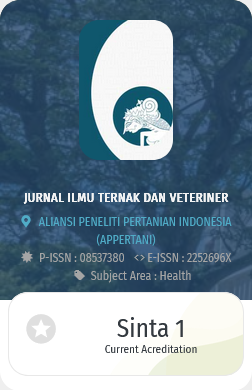Molecular characterization of Bovine herpesvirus type 1 Indonesian isolates
Abstract
Different subtypes of bovine herpesvirus 1 (BHV-1) have been associated with different clinical conditions of cattle. For that reason subtypes differentiation has become an essential tool for understanding the pathogenesis and epidemiology of BHV infections. In search for a genomic region that would allow a clear distinction between BHV-1.1 and BHV-1.2 of glycoprotein D (gD) genes of 8 Indonesian isolates were amplified and sequenced. The amino acid sequence alignments revealed that the levels of genomic similarity ranging from 98.8 to 100% among BHV-1 Indonesian isolates and its results were also similar between BHV-1 Indonesia isolates and BHV-1.1 reference, and 98.4 to 98.8% between BHV-1 Indonesian isolates and BHV-1.2 reference. The isolates could be clearly separated into BHV-1.1 and BHV-1.2 after phylogenetic analysis. The results showed that the Indonesian isolates were characterized as BHV-1.1 as agent caused respiratory tract infections in cattle or infectious bovine rhinotracheitis (IBR) disease. The results suggest that the phylogenetic analysis performed here can be used as a potential molecular epidemiological tool for herpesviruses.
Key Words: BHV-1.1, BHV-1.2, Glycoprotein D, Phylogenetic Analysis, IBR
Full Text:
PDFRefbacks
- There are currently no refbacks.

This work is licensed under a Creative Commons Attribution 4.0 International License.































